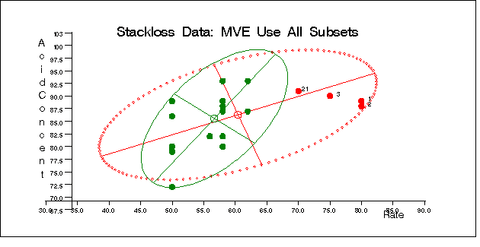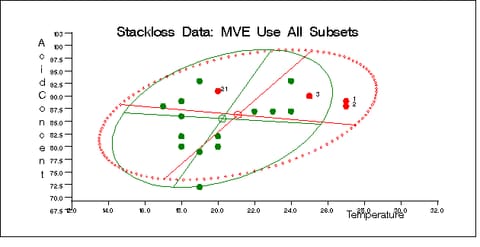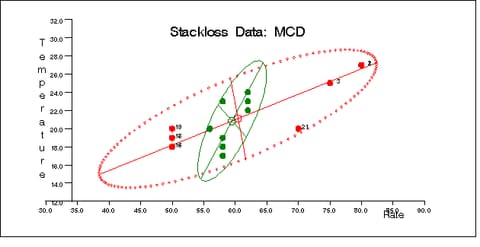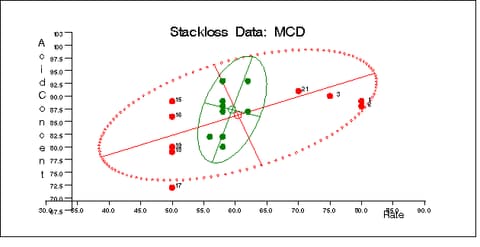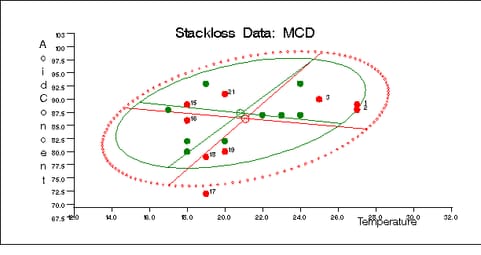Example 12.5 Stackloss Data
The following example analyzes the three regressors of Brownlee (1965) stackloss data. By default, the MVE subroutine tries only 2000 randomly selected subsets in its search. There are, in total, 5985 subsets of 4 cases out of 21 cases. Here is the code:
title2 "***MVE for Stackloss Data***";
title3 "*** Use All Subsets***";
aa = { 1 80 27 89 42,
1 80 27 88 37,
1 75 25 90 37,
1 62 24 87 28,
1 62 22 87 18,
1 62 23 87 18,
1 62 24 93 19,
1 62 24 93 20,
1 58 23 87 15,
1 58 18 80 14,
1 58 18 89 14,
1 58 17 88 13,
1 58 18 82 11,
1 58 19 93 12,
1 50 18 89 8,
1 50 18 86 7,
1 50 19 72 8,
1 50 19 79 8,
1 50 20 80 9,
1 56 20 82 15,
1 70 20 91 15 };
a = aa[,2:4];
optn = j(9,1,.);
optn[1]= 2; /* ipri */
optn[2]= 1; /* pcov: print COV */
optn[3]= 1; /* pcor: print CORR */
optn[5]= -1; /* nrep: use all subsets */
call mve(sc,xmve,dist,optn,a);
Output 12.5.1 of the output shows the classical scatter and correlation matrix.
Output 12.5.1
Some Simple Statistics
| 84.057142857 |
22.657142857 |
24.571428571 |
| 22.657142857 |
9.9904761905 |
6.6214285714 |
| 24.571428571 |
6.6214285714 |
28.714285714 |
| 1 |
0.781852333 |
0.5001428749 |
| 0.781852333 |
1 |
0.3909395378 |
| 0.5001428749 |
0.3909395378 |
1 |
| 60.428571429 |
| 21.095238095 |
| 86.285714286 |
Output 12.5.2 shows the results of the optimization (complete subset sampling).
Output 12.5.2
Iteration History
| 1497 |
22 |
253.312431 |
25 |
| 2993 |
46 |
224.084073 |
50 |
| 4489 |
77 |
165.830053 |
75 |
| 5985 |
156 |
165.634363 |
100 |
| 34.829014749 |
28.413143611 |
62.32560534 |
| 28.413143611 |
38.036950318 |
58.659393261 |
| 62.32560534 |
58.659393261 |
267.63348175 |
Output 12.5.3 shows the optimization results after local improvement.
Output 12.5.3
Table of MVE Results
| 56.705882353 |
| 20.235294118 |
| 85.529411765 |
| 23.470588235 |
7.5735294118 |
16.102941176 |
| 7.5735294118 |
6.3161764706 |
5.3676470588 |
| 16.102941176 |
5.3676470588 |
32.389705882 |
| 46.597431018 |
| 12.155938483 |
| 3.423101087 |
| 1 |
0.6220269501 |
0.5840361335 |
| 0.6220269501 |
1 |
0.375278187 |
| 0.5840361335 |
0.375278187 |
1 |
Output 12.5.4 presents a table that contains the classical Mahalanobis distances, the robust distances, and the weights identifying the outlying observations (that is, the leverage points when explaining  with these three regressor variables).
with these three regressor variables).
Output 12.5.4
Mahalanobis and Robust Distances
| 2.253603 |
5.528395 |
0 |
| 2.324745 |
5.637357 |
0 |
| 1.593712 |
4.197235 |
0 |
| 1.271898 |
1.588734 |
1.000000 |
| 0.303357 |
1.189335 |
1.000000 |
| 0.772895 |
1.308038 |
1.000000 |
| 1.852661 |
1.715924 |
1.000000 |
| 1.852661 |
1.715924 |
1.000000 |
| 1.360622 |
1.226680 |
1.000000 |
| 1.745997 |
1.936256 |
1.000000 |
| 1.465702 |
1.493509 |
1.000000 |
| 1.841504 |
1.913079 |
1.000000 |
| 1.482649 |
1.659943 |
1.000000 |
| 1.778785 |
1.689210 |
1.000000 |
| 1.690241 |
2.230109 |
1.000000 |
| 1.291934 |
1.767582 |
1.000000 |
| 2.700016 |
2.431021 |
1.000000 |
| 1.503155 |
1.523316 |
1.000000 |
| 1.593221 |
1.710165 |
1.000000 |
| 0.807054 |
0.675124 |
1.000000 |
| 2.176761 |
3.657281 |
0 |
The following specification generates three bivariate plots of the classical and robust tolerance ellipsoids. They are shown in Figure 12.5.5, Figure 12.5.6, and Figure 12.5.7, one plot for each pair of variables.
optn = j(9,1,.); optn[5]= -1;
vnam = { "Rate", "Temperature", "AcidConcent" };
filn = "stlmve";
titl = "Stackloss Data: Use All Subsets";
%include 'robustmc.sas';
call scatmve(2,optn,.9,a,vnam,titl,1,filn);
Output 12.5.5
Stackloss Data: Rate vs. Temperature (MVE)
Output 12.5.6
Stackloss Data: Rate vs. Acid Concentration (MVE)
Output 12.5.7
Stackloss Data: Temperature vs. Acid Concentration (MVE)
You can also use the MCD method for the stackloss data as follows:
title2 "***MCD for Stackloss Data***";
title3 "*** Use 500 Random Subsets***";
a = aa[,2:4];
optn = j(8,1,.);
optn[1]= 2; /* ipri */
optn[2]= 1; /* pcov: print COV */
optn[3]= 1; /* pcor: print CORR */
optn[5]= -1 ; /* nrep: use all subsets */
call mcd(sc,xmcd,dist,optn,a);
The optimization results are displayed in Output 12.5.8. The reweighted results are displayed in Output 12.5.9.
Output 12.5.8
MCD Results of Optimization
| 4 |
5 |
6 |
7 |
8 |
9 |
10 |
11 |
12 |
13 |
14 |
20 |
| 59.5 |
20.833333333 |
87.333333333 |
| 5.1818181818 |
4.8181818182 |
4.7272727273 |
| 4.8181818182 |
7.6060606061 |
5.0606060606 |
| 4.7272727273 |
5.0606060606 |
19.151515152 |
| 1 |
0.7674714142 |
0.4745347313 |
| 0.7674714142 |
1 |
0.4192963398 |
| 0.4745347313 |
0.4192963398 |
1 |
| 8.6578437815 |
8.0502757968 |
7.8983838007 |
| 8.0502757968 |
12.708297013 |
8.4553211199 |
| 7.8983838007 |
8.4553211199 |
31.998580526 |
Output 12.5.9
Final Reweighted MCD Results
| 59.5 |
20.833333333 |
87.333333333 |
| 5.1818181818 |
4.8181818182 |
4.7272727273 |
| 4.8181818182 |
7.6060606061 |
5.0606060606 |
| 4.7272727273 |
5.0606060606 |
19.151515152 |
| 23.191069268 |
7.3520037086 |
1.3963209628 |
| 1 |
0.7674714142 |
0.4745347313 |
| 0.7674714142 |
1 |
0.4192963398 |
| 0.4745347313 |
0.4192963398 |
1 |
The MCD robust distances and outlying diagnostic are displayed in Output 12.5.10. MCD identifies more leverage points than MVE.
Output 12.5.10
MCD Robust Distances
| 2.253603 |
12.173282 |
0 |
| 2.324745 |
12.255677 |
0 |
| 1.593712 |
9.263990 |
0 |
| 1.271898 |
1.401368 |
1.000000 |
| 0.303357 |
1.420020 |
1.000000 |
| 0.772895 |
1.291188 |
1.000000 |
| 1.852661 |
1.460370 |
1.000000 |
| 1.852661 |
1.460370 |
1.000000 |
| 1.360622 |
2.120590 |
1.000000 |
| 1.745997 |
1.809708 |
1.000000 |
| 1.465702 |
1.362278 |
1.000000 |
| 1.841504 |
1.667437 |
1.000000 |
| 1.482649 |
1.416724 |
1.000000 |
| 1.778785 |
1.988240 |
1.000000 |
| 1.690241 |
5.874858 |
0 |
| 1.291934 |
5.606157 |
0 |
| 2.700016 |
6.133319 |
0 |
| 1.503155 |
5.760432 |
0 |
| 1.593221 |
6.156248 |
0 |
| 0.807054 |
2.172300 |
1.000000 |
| 2.176761 |
7.622769 |
0 |
Similarly, you can use the SCATMCD routine to generate three bivariate plots of the classical and robust tolerance ellipsoids, one plot for each pair of variables. Here is the code:
optn = j(9,1,.); optn[5]= -1;
vnam = { "Rate", "Temperature", "AcidConcent" };
filn = "stlmcd";
titl = "Stackloss Data: Use All Subsets";
%include 'robustmc.sas';
call scatmcd(2,optn,.9,a,vnam,titl,1,filn);
Figure 12.5.11, Figure 12.5.12, and Figure 12.5.13 display these plots.
Output 12.5.11
Stackloss Data: Rate vs. Temperature (MCD)
Output 12.5.12
Stackloss Data: Rate vs. Acid Concentration (MCD)
Output 12.5.13
Stackloss Data: Temperature vs. Acid Concentration (MCD)
 with these three regressor variables).
with these three regressor variables). 
